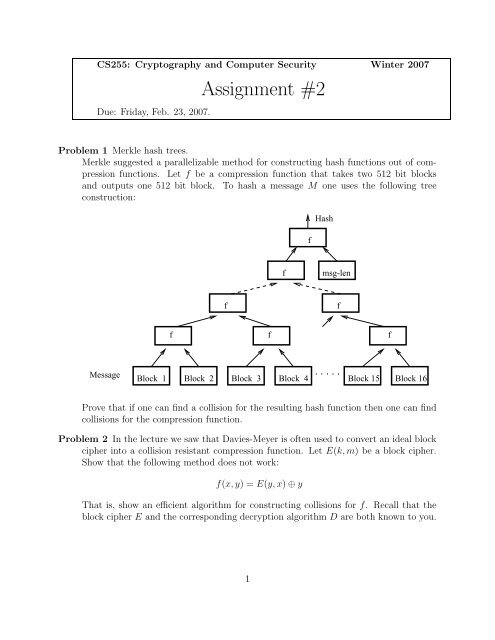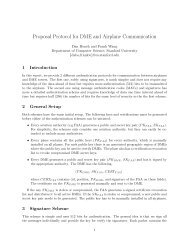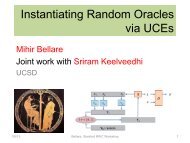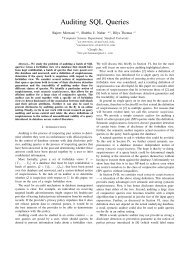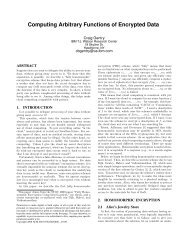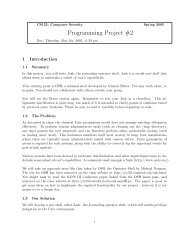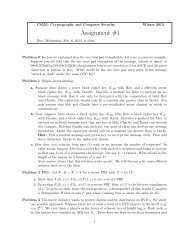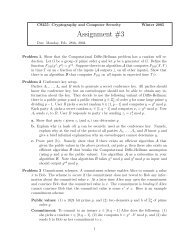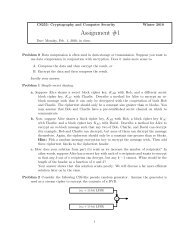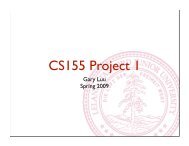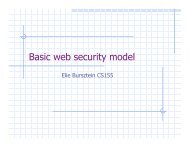Assignment #2 - Applied Crypto Group at Stanford University
Assignment #2 - Applied Crypto Group at Stanford University
Assignment #2 - Applied Crypto Group at Stanford University
Create successful ePaper yourself
Turn your PDF publications into a flip-book with our unique Google optimized e-Paper software.
CS255: <strong>Crypto</strong>graphy and Computer Security Winter 2007<br />
Due: Friday, Feb. 23, 2007.<br />
<strong>Assignment</strong> <strong>#2</strong><br />
Problem 1 Merkle hash trees.<br />
Merkle suggested a parallelizable method for constructing hash functions out of compression<br />
functions. Let f be a compression function th<strong>at</strong> takes two 512 bit blocks<br />
and outputs one 512 bit block. To hash a message M one uses the following tree<br />
construction:<br />
Message<br />
f<br />
Hash<br />
msg-len<br />
f f f<br />
Block 1 Block 2 Block 3 Block 4 Block 15<br />
f<br />
f<br />
f<br />
Block 16<br />
Prove th<strong>at</strong> if one can find a collision for the resulting hash function then one can find<br />
collisions for the compression function.<br />
Problem 2 In the lecture we saw th<strong>at</strong> Davies-Meyer is often used to convert an ideal block<br />
cipher into a collision resistant compression function. Let E(k, m) be a block cipher.<br />
Show th<strong>at</strong> the following method does not work:<br />
f(x, y) = E(y, x) ⊕ y<br />
Th<strong>at</strong> is, show an efficient algorithm for constructing collisions for f. Recall th<strong>at</strong> the<br />
block cipher E and the corresponding decryption algorithm D are both known to you.<br />
1
Problem 3 Suppose user A is broadcasting packets to n recipients B1, . . . , Bn. Privacy is<br />
not important but integrity is. In other words, each of B1, . . . , Bn should be assured<br />
th<strong>at</strong> the packets he is receiving were sent by A. User A decides to use a MAC.<br />
a. Suppose user A and B1, . . . , Bn all share a secret key k. User A MACs every packet<br />
she sends using k. Each user Bi can then verify the MAC. Using <strong>at</strong> most two<br />
sentences explain why this scheme is insecure, namely, show th<strong>at</strong> user B1 is not<br />
assured th<strong>at</strong> packets he is receiving are from A.<br />
b. Suppose user A has a set S = {k1, . . . , km} of m secret keys. Each user Bi has some<br />
subset Si ⊆ S of the keys. When A transmits a packet she appends m MACs<br />
to it by MACing the packet with each of her m keys. When user Bi receives a<br />
packet he accepts it as valid only if all MAC’s corresponding to keys in Si are<br />
valid. Wh<strong>at</strong> property should the sets S1, . . . , Sn s<strong>at</strong>isfy so th<strong>at</strong> the <strong>at</strong>tack from<br />
part (a) does not apply? We are assuming all users B1, . . . , Bn are sufficiently far<br />
apart so th<strong>at</strong> they cannot collude.<br />
c. Show th<strong>at</strong> when n = 6 (i.e. six recipients) the broadcaster A need only append<br />
4 MAC’s to every packet to s<strong>at</strong>isfy the condition of part (b). Describe the sets<br />
S1, . . . , S6 ⊆ {k1, . . . , k4} you would use.<br />
Problem 4 Strengthening hashes and MACs.<br />
a. Suppose we are given two hash functions H1, H2 : {0, 1} ∗ → {0, 1} n (for example<br />
SHA1 and MD5) and are told th<strong>at</strong> both hash functions are collision resistant.<br />
We, however, do not quite trust these claims. Our goal is to build a hash function<br />
H12 : {0, 1} ∗ → {0, 1} m th<strong>at</strong> is collision resistant assuming <strong>at</strong> least one of H1, H2<br />
are collision resistant. Give the best construction you can for H12 and prove th<strong>at</strong><br />
a collision finder for your H12 can be used to find collisions for both H1 and H2<br />
(this will prove collision resistance of H12 assuming one of H1 or H2 is collision<br />
resistant). Note th<strong>at</strong> a straight forward construction for H12 is fine, as long as<br />
you prove security in the sense above.<br />
b. Same questions as part (a) for Message Authentic<strong>at</strong>ion Codes (MACs). Prove<br />
th<strong>at</strong> an existential forger under a chosen message <strong>at</strong>tack on your MAC12 gives<br />
an existential forger under a chosen message <strong>at</strong>tack for both MAC1 and MAC2.<br />
Again, a straight forward construction is acceptable, as long as you prove security.<br />
The proof of security here is a bit more involved than in part (a).<br />
Problem 5 In this problem, we see why it is a really bad idea to choose a prime p = 2 k + 1<br />
for discrete-log based protocols: the discrete logarithm can be efficiently computed for<br />
such p. Let g be a gener<strong>at</strong>or of Z ∗ p.<br />
a. Show how one can compute the least significant bit of the discrete log. Th<strong>at</strong> is,<br />
given y = g x (with x unknown), show how to determine whether x is even or odd<br />
by computing y (p−1)/2 mod p.<br />
2
. If x is even, show how to compute the 2nd least significant bit of x.<br />
Hint: consider y (p−1)/4 mod p.<br />
c. Generalize part (b) and show how to compute all of x.<br />
Hint: let b ∈ {0, 1} be the LSB of x obtained using part (a). Try setting y1 ← y/g b<br />
and observe th<strong>at</strong> y1 is an even power of g. Then use part (b) to deduce the second<br />
least significant bit of x. Show how to iter<strong>at</strong>e this procedure to recover all of x.<br />
d. Briefly explain why your algorithm does not work for a random prime p.<br />
3


